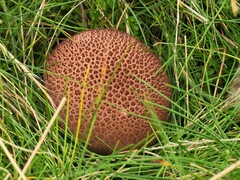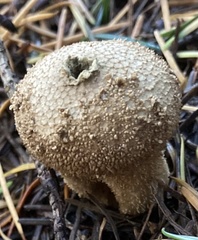Lycoperdon nigrescens: taxon details and analytics
- Domain
- Kingdom
- Fungi
- Phylum
- Basidiomycota
- Class
- Agaricomycetes
- Order
- Agaricales
- Family
- Lycoperdaceae
- Genus
- Lycoperdon
- Species
- Lycoperdon nigrescens
- Scientific Name
- Lycoperdon nigrescens
Summary description from Wikipedia:
Lycoperdon nigrescens
Lycoperdon nigrescens, with the synonym Lycoperdon foetidum, commonly known as the dusky puffball, is a type of puffball mushroom in the genus Lycoperdon. It was first described scientifically in 1794 by the Swedish naturalist Göran Wahlenberg.
The fruit body grows up to 6 centimetres (2+1⁄4 in) tall and 4 cm (1+1⁄2 in) wide. The caps are shaped somewhat like pears, with spines ranging in brightness, which later break off. The surface is dark between the spines. The stipe has thin strands coming from its base. Visually similar to other species when young, it grows increasingly darker with age and lacks the pronounced stipe that old Lycoperdon perlatum specimens attain.
It appears from summer to fall in both conifer and hardwood forests, in addition to alpine areas. Its edibility is unknown, but related puffballs are edible in youth, when still firm and white inside.
...Lycoperdon nigrescens in languages:
- Bokmål
- mørk vorterøyksopp
- Chinese
- 昏暗馬勃
- Czech
- pýchavka horská
- Danish
- Sortagtig støvbold
- Dutch
- Zwartwordende stuifzwam
- English
- Dusky Puffball
- Hungarian
- büdös pöfeteg
- Japanese
- クロホコリタケ
- Korean
- 악취말불버섯
- Lithuanian
- Juostantysis pumpotaukšlis
- Russian
- Дождевик чернеющий
- Swedish
- mörk röksvamp
Images from inaturalist.org observations:
We recommend you sign up for this excellent, free service.
Parent Taxon
Sibling Taxa
- Bovistella ohiensis
- Bovistella utriformis
- Handkea fumosa
- Lycoperdon abscissum
- Lycoperdon americanum
- Lycoperdon angulatum
- Lycoperdon asperrimum
- Lycoperdon asperum
- Lycoperdon atropurpureum
- Lycoperdon bicolor
- Lycoperdon bispinosum
- Lycoperdon caespitosum
- Lycoperdon caffrorum
- Lycoperdon calyptriforme
- Lycoperdon candidum
- Lycoperdon caudatum
- Lycoperdon compactum
- Lycoperdon cruciatum
- Lycoperdon curtisii
- Lycoperdon decipiens
- Lycoperdon delicatum
- Lycoperdon dermoxanthum
- Lycoperdon duthiei
- Lycoperdon echinatum
- Lycoperdon echinella
- Lycoperdon ericaeum
- Lycoperdon estonicum
- Lycoperdon excipuliforme
- Lycoperdon eximium
- Lycoperdon flavotinctum
- Lycoperdon floccosum
- Lycoperdon frigidum
- Lycoperdon fuligineum
- Lycoperdon fuscum
- Lycoperdon glabellum
- Lycoperdon glabrescens
- Lycoperdon lambinonii
- Lycoperdon lividum
- Lycoperdon mammiforme
- Lycoperdon marginatum
- Lycoperdon mauryanum
- Lycoperdon mixtecorum
- Lycoperdon molle
- Lycoperdon muscorum
- Lycoperdon nettyanum
- Lycoperdon nigrescens
- Lycoperdon nitidum
- Lycoperdon norvegicum
- Lycoperdon oblongisporum
- Lycoperdon peckii
- Lycoperdon perlatum
- Lycoperdon polymorphum
- Lycoperdon pratense
- Lycoperdon pseudogemmatum
- Lycoperdon pulcherrimum
- Lycoperdon purpurascens
- Lycoperdon radicatum
- Lycoperdon rimulatum
- Lycoperdon rupicola
- Lycoperdon scabrum
- Lycoperdon spadiceum
- Lycoperdon subcretaceum
- Lycoperdon subincarnatum
- Lycoperdon subpratense
- Lycoperdon subumbrinum
- Lycoperdon tabacinum
- Lycoperdon tessellatum
- Lycoperdon umbrinoides
- Lycoperdon umbrinum
- Lycoperdon utriforme
- Lycoperdon velutinum
- Lycoperdon wrightii
- Vascellum cingulatum
- Vascellum cuzcoense
- Vascellum delicatum
- Vascellum djurense
- Vascellum floridanum
- Vascellum intermedium
- Vascellum lloydianum
- Vascellum qudenii































































































































































